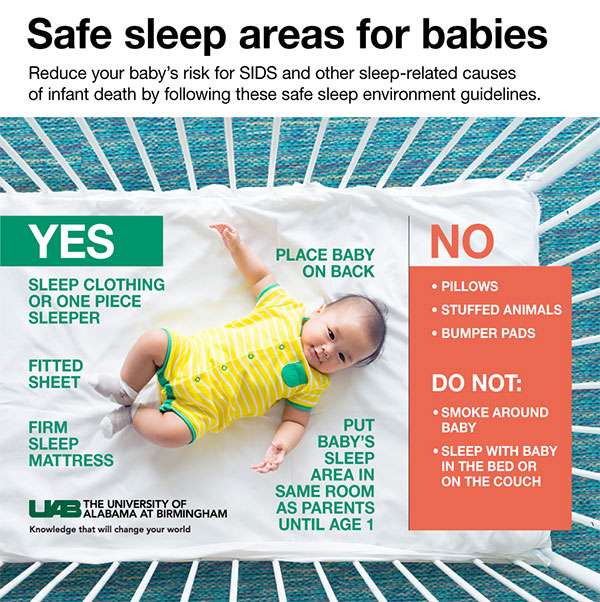 A new study from the University of Alabama at Birmingham shows that national magazine advertisements and manufacturers of infant cribs continue to depict unsafe sleep environments, despite longtime guidelines established by the American Academy of Pediatrics to protect against SIDS and other sleep-related deaths.
A new study from the University of Alabama at Birmingham shows that national magazine advertisements and manufacturers of infant cribs continue to depict unsafe sleep environments, despite longtime guidelines established by the American Academy of Pediatrics to protect against SIDS and other sleep-related deaths.
“It is important that health care providers, advertisers and crib manufacturers come together to educate parents and caregivers about safe sleep environments for children,” said Bradley Troxler, M.D., assistant professor and director of the UAB Pediatric Pulmonary Center who treats patients at Children’s of Alabama. “Advertisers and manufacturers should encourage new parents to follow guidelines by being the example in their published materials.”
The study published in Pediatrics, “Safe Sleep Guideline Adherence in Nationwide Marketing of Infant Cribs and Products,” analyzed 1,758 crib advertisements and 1,893 print magazine advertisements from 1992, 2010 and 2015.
Improvements have been made over time; however, the study found that 40 percent of current advertisements depicting sleep environments for children 1 year of age or younger failed to adhere to safe sleep recommendations. Most of the crib displays that depicted unsafe sleep environments showed bumper pads and/or soft bedding, both of which have been associated with sudden infant death syndrome or other sleep-related deaths, according to research.
The authors conclude that health care providers should broaden current educational and advocacy efforts beyond parents and caregivers to include advertisers, stores and crib manufacturers. Special attention should also be given to the messaging involving nonwhite infants and sleep, the study concludes. While white children were featured in most of the advertisements, none of the ads that featured definitively nonwhite children adhered to safe-sleep guidelines.
The American Academy of Pediatrics describes a safe sleeping environment:
- Infants should not sleep in a bed, on a couch or in a chair with an adult or alone
- Sleep areas next to a parent’s bed should be a separate bassinet or crib
- Clothing should fit the baby and should not be loose or baggy
- Refrain from using any extra bedding, blankets, bumpers and pillows in the crib; a tight, fitted sheet is all that is needed
- Toys and stuffed animals should not be in the baby’s sleep area
- Use a firm safety-approved crib mattress with a fitted sheet
- The baby’s head should never be covered
- Always place an infant on his or her back to sleep
- Do not smoke or let anyone smoke around the baby
Investigators on the study include Troxler; Matthew Kreth, M.D., former fellow in UAB’s Department of Pediatrics; Tammy Shikany, respiratory therapist in the UAB PPC; and Claire Lenker, clinical social worker in the UAB PPC.